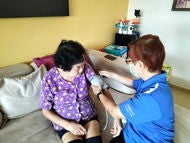SingHealth Institutions will NEVER ask you to transfer money over a call. If in doubt, call the 24/7 ScamShield helpline at 1799, or visit the ScamShield website at www.scamshield.gov.sg.

As a sign and recognition of the growing collaboration and successful team work across ACPs and Duke-NUS within the SingHealth Duke-NUS Academic Medical Centre, we are delighted and pleased to share that a team of researchers were selected as award winners for the Distinguished Clinical Study 2014!
This award, supported by the Society of Interventional Radiology Foundation, acknowledges the essential, best-in-class research that is conducted in interventional radiology and published within the official journal – Journal of Vascular and Interventional Radiology.
The paper, titled Randomized Clinical Trial of Cutting Balloon Angioplasty versus High-Pressure Balloon Angioplasty in Hemodialysis Arteriovenous Fistula Stenoses Resistant to Conventional Balloon Angioplasty, was chosen by a review of all manuscripts published in 2014, voted by the editorial board members, and selected by the editor-in-chief.
Authors, co-authors and contributors
• Dr Aftab Syed Arafat, Duke-NUS Graduate Medical School/SingHealth Resident
• Dr Tay Kiang Hiong, Radiological Sciences ACP (SGH Dept of Diagnostic Radiology)
• Dr Farah G Irani, Radiological Sciences ACP (SGH Dept of Diagnostic Radiology)
• Dr Richard Lo Hoau Gong, Radiological Sciences ACP (SGH Dept of Diagnostic Radiology)
• Dr Apoorva Gogna, Radiological Sciences ACP (SGH Dept of Diagnostic Radiology)
• Dr Benjamin Haaland, Duke-NUS Graduate Medical School
• Dr Tan Seck Guan, Surgery ACP (SGH Dept of Vascular Surgery)
• Dr Chng Siew Ping, Surgery ACP (SGH Dept of Vascular Surgery)
• Dr Shanker Pasupathy, Surgery ACP (SGH Dept of Upper GI / Bariatric Surgery)
• Dr Choong Hui Lin, Medicine ACP (SGH Dept of Renal Medicine)
• Dr Tan Bien Soo, Radiological Sciences ACP (SGH Dept of Diagnostic Radiology)
Abstract (extracted from JVIR)
Purpose
To compare the efficacy and safety of cutting balloon angioplasty (CBA) versus high-pressure balloon angioplasty (HPBA) for the treatment of hemodialysis autogenous fistula stenoses resistant to conventional percutaneous transluminal angioplasty (PTA).
Materials and Methods
In a prospective, randomized clinical trial involving patients with dysfunctional, stenotic hemodialysis arteriovenous fistulas (AVFs), patients were randomized to receive CBA or HPBA if conventional PTA had suboptimal results (ie, residual stenosis > 30%). A total of 516 patients consented to participate in the study from October 2008 to September 2011, 85% of whom (n = 439) had technically successful conventional PTA. The remaining 71 patients (mean age, 60 y; 49 men) with suboptimal PTA results were eventually randomized: 36 to the CBA arm and 35 to the HPBA arm. Primary and secondary target lesion patencies were determined by Kaplan–Meier analysis.
Results
Clinical success rates were 100% in both arms. Primary target lesion patency rates at 6 months were 66.4% and 39.9% for CBA and HPBA, respectively (P = .01). Secondary target lesion patency rates at 6 months were 96.5% for CBA and 80.0% for HPBA (P = .03). There was a single major complication of venous perforation following CBA. The 30-day mortality rate was 1.4%, with one non–procedure-related death in the HPBA group.
Conclusions
Primary and secondary target lesion patency rates of CBA were statistically superior to those of HPBA following suboptimal conventional PTA. For AVF stenoses resistant to conventional PTA, CBA may be a better second-line treatment given its superior patency rates
Article extracted with permission from the Academic Medicine Partners Portal
Keep Healthy With
© 2025 SingHealth Group. All Rights Reserved.



















